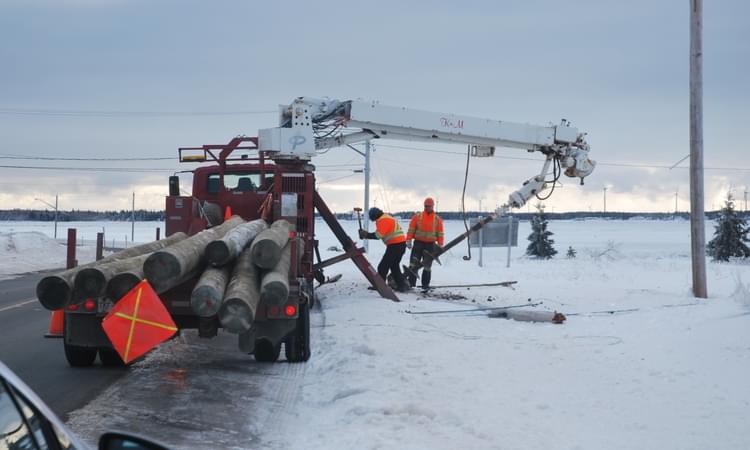UPDATED: NB Power plans faster response to ice storm debris – Telegraph Journal – 14 November 2017

Author by: JOHN CHILIBECK Legislature Bureau
Photo by: Ernesto Carranza/Miramichi Leader
You can’t predict where the next ice storm will hit. It could hit southeastern New Brunswick, it could hit Memramcook, it could hit Charlotte County – David Coon
NB Power utility workers work well into the evening to get new power poles up on Miscou Island after the January ice storm.
NB Power has put in several measures to avoid the kind of disaster last winter that led to half the province losing electricity, but one of them is utterly simple: sending teams out to remove debris from roadways ahead of the crews who put new power poles back up.
CEO Gaëtan Thomas told Brunswick News in an interview the public utility was caught flat-footed last January when a major storm left trees, poles and lines loaded with heavy ice.
Many of the trees and poles toppled, leaving about 30 roads in rural areas, mostly in the northeastern part of the province, impassable.
“You always learn from your experience in every storm and what we learned from the ice storm was our assessment of the damage was a little slow initially,” Thomas said. “In future, crews will be mobilized more quickly to clear roadways of poles and trees so we can do a better damage assessment and fix problems quicker.”
It took NB Power 13 days to restore electricity across the province and at the peak of the outage, almost 300,000 were affected. On the Acadian Peninsula, two people died and dozens became sick from inhaling carbon monoxide after trying to stay warm with their own generators that weren’t properly ventilated.
“We’re confident that if the same storm happened today, the outages wouldn’t last as long,” the CEO said.
Thomas made the comments in the context of storm preparedness week, which just ended. The utility and the provincial government are pushing people to be “72 hours ready,” that is, prepared to go without electricity for as much as three days in the event of a disaster.
For its part, the utility has already fixed poles that collapsed under heavy loads with more guy-wiring or anchoring and reinforced transmission lines with more metal. By the end of December, it hopes to have better secured the major lines that feed Miscou Island that have failed twice this year alone.
Rick Doucet, the minister of energy and resource development, said in an interview Tuesday that while he’s pleased with the measures NB Power has taken, he believes people would be foolhardy to believe an outage like what happened last January couldn’t happen again.
“We can’t be naive to think this won’t happen again. Climate change is upon us, we’re seeing more storms, bigger storms, we’re seeing storm after storm after storm. I look at this and the response they’ve put in place, and we need to learn lessons from it.”
Doucet said it might seem simple to clear roads of debris, but it takes specially trained people to handle high-voltage wires, which, for safety reasons, must be treated as live.
“NB Power’s going to have to lead the charge on that and get out there and get this stuff, the debris, out of the way,” he said. “We’ve had ice storms in the past, but they didn’t create the problem we had this last time. And more of this is coming just around the corner.”
Some critics believe NB Power must be more aggressive in strengthening its infrastructure to handle future storms.
While Thomas said it would take at least a decade to secure poles as well as they have been in the Acadian Peninsula, Green Party leader David Coon said that’s not good enough.
“You can’t predict where the next ice storm will hit,” he said in an interview Tuesday. “It could hit southeastern New Brunswick, it could hit Memramcook, it could hit Charlotte County.”